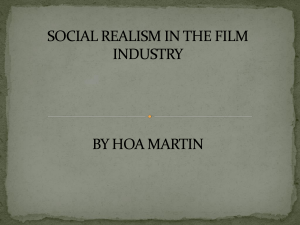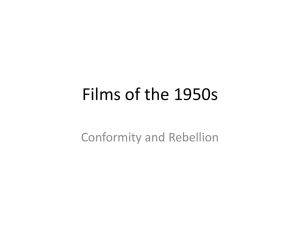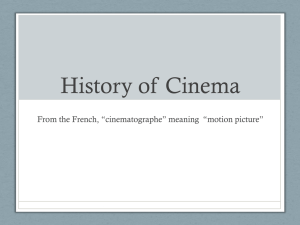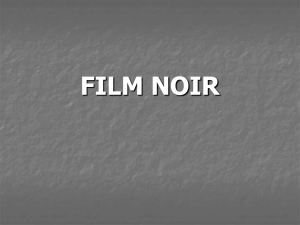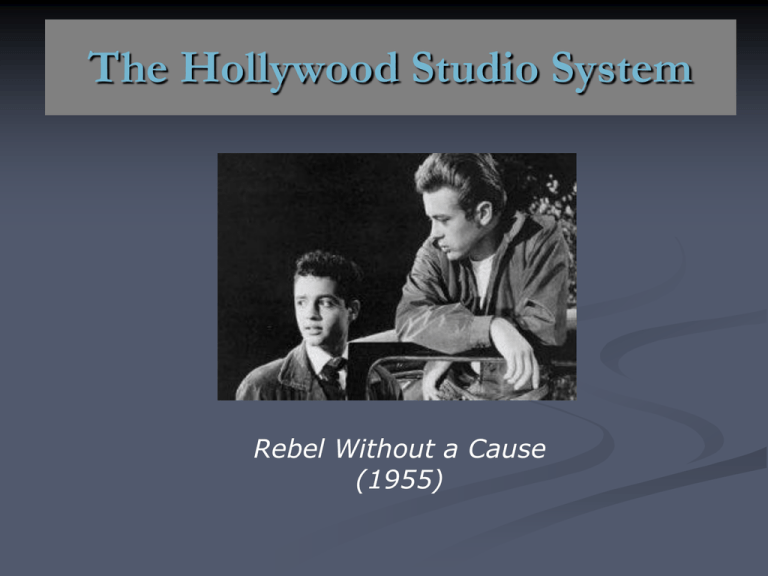
The Hollywood Studio System
Rebel Without a Cause
(1955)
The Studio System
Some have compared the Hollywood studio system to a
factory, and it is useful to remember that studios were out to
make money first and art second. Their product output in 1937
surged to over 500 feature films. By the 1980s, this figure
dropped to an average of 100 films per year. During the
Golden Age, the studios were remarkably consistent and stable
enterprises, due in large part to long-term management heads-the infamous "movie moguls" who ruled their kingdoms with
iron fists. At MGM, Warner Bros. and Columbia, the same
fabled immigrant showmen ran their studios for decades.
Power, then, was definitely situated with the studio heads.
The rise of the studio system also hinges on the
treatment of stars, who were constructed and
exploited to suit a studio's image and schedule.
Actors and actresses were contract players bound up
in seven-year contracts to a single studio, and the
studio generally held all the options. Stars could be
loaned out to other production companies at any time.
Studios could also force bad roles on actors, and
control the minutiae of stars' images with their
mammoth in-house publicity departments.
Niche studio styles
The biggest cache of stars (Greta Garbo, Joan Crawford
and Spencer Tracey, among others) and tended to put
out a lot of all-star productions, such as Grand Hotel
(1932). Paramount excelled in comedy, having Mae
West, W.C. Fields, the Marx Brothers, Bob Hope and
Bing Crosby at their disposal. Warner Bros.
developed a reputation for gritty social realism,
ranging from gangster pictures, which were often
based on newspaper headlines, to war pictures and
Westerns. 20th Century Fox forged the musical and a
great deal of prestige biographies, such as Young Mr.
Lincoln (1939).
RKO provided a haven for Orson Welles
(Citizen Kane, The Magnificent Ambersons,
etc.) and dance supernovas, Fred Astaire and
Ginger Rogers. RKO also created King Kong
(1933). Columbia's major claim was director
Frank Capra, including his masterpieces It
Happened One Night (1934) and Mr. Deeds
Goes To Town (1936), among others
Universal thrilled and terrified audiences with
the original Frankenstein (1931), Dracula
(1931) and The Wolf Man (1941). United
Artists, formed by silent greats Charlie
Chaplin, Mary Pickford, D.W. Griffith and
Douglas Fairbanks, specialized in distributing
productions.
Early censorship
Despite the early proliferation of film production that occurred
during the classical Hollywood period, studios were also
challenged by growing governmental censorship efforts that
aimed to limit audience-pleasing films filled with unnecessary
sex and violence. The movies were born as a low form of
entertainment, and early on certain groups decried the movies'
capacity to lower morals. Stars' scandalous cavorting--most
notably, Fatty Arbuckle's conviction for a kinky sex-related
murder of a model in 1921--increasingly threatened the
public's good graces towards the motion-picture industry. By
1922, it looked as if the studios faced imminent government
intervention.
Rather than risk government intervention, the
studios put William Hays, former Postmaster
General of the United States, at the helm of the
Motion Pictures Producers and Distributors of
America organization (MPPDA), in the hopes
of adequately self-censoring before the
government intervened. The MPPDA also
assembled a Production Code in 1930, a
document that outlined, in excruciating detail,
what could not be shown or said in movies.
Though this system ultimately broke down (the
current rating system was adopted in 1968),
the mesmerizing power of movies to both
exhilarate and corrupt audiences remains a
central American preoccupation. For example,
Hollywood films are still criticized for the way
in which they seduce underage viewers.
The Three Elements
Vertical Integration:
Production – The Making of the Movies
Distribution – The network that brought the
films to the public – promotion, run times
Exhibition – The “Big Five” owned their own
theatres
Hollywood in the Twenties
After the first world war and with the destruction of much structure of
European cinema, Hollywood established itself as the world capital of the
film industry. This was also the result of the founding of major studios and
the practice of what came to be called factory film making.
The way films were made quickly became standardize as the studios
became organized and different people were assigned specific tasks. This
cut cost drastically because, instead of each film having to have its own
crew of various specialists, the different departments - props and scenery,
costumes and make-up, advertisement and distribution, scripting and
editing - worked on several films at the same time.
Buster Keaton in Steamboat Bill Jr. (1924)
One of the first architects of the American studio system, Mack Sennett, is
also responsible for establishing slapstick comedy as one of the dominate
forms of silent cinema. In 1912 Sennett founded Keystone Studios, where
over the years he produced thousands of one and two-reel shorts and
hundreds of features.
A great number of Hollywood figures began their careers at Keystone,
including Buster Keaton, Fatty Arbuckle, Gloria Swanson, Carole
Lombard, W. C. Fields, and Frank Capra. Sennett’s most famous protégé
was Charlie Chaplin, who first developed his famous tramp character while
working at Keystone.
W. C. Fields in Pool Sharks (1915)
By 1917 Chaplin had gained such star-power that he was offered a onemillion-dollar contract with First National to produce eight films. This
deals enabled him to establish his own studio, where he made all of his
films from 1918 until he left the U.S. in 1952.
In 1919, along with D. W. Griffith, Mary Pickford, and Douglas
Fairbanks, Chaplin formed United Artists which was at first solely a
distribution company that allow them a way of competing with the
bigger studios. With the combined financing of United Artists Chaplin
was allowed total control to create a body of work that sophistically
deals with the human condition and modern life.
His great films include The Gold Rush, City Lights, Modern Times, The
Great Dictator, and Limelight.
In 1953, while Chaplin was on tour in Britain, He received a telegram
from the U.S. State Department denying him entrance back into the
U.S. unless he agreed to appear before a board of inquiry to answer
charges of political and moral turpitude. Chaplin refused and later
responded by making the 1957 film A King of New York, a film about a
European head of state who comes to America and his ruined by
malicious charges by the House Un-American Activities Committee.
The “Big Five”
The Jazz Singer, 1927
The Studio moguls
The “Big Five” and “Little
Three” (Universal, United
Artists, Columbia)
controlled 95% of the
theatres in the US
This system begins to take
root in the 1920s and takes
off the in the 1930s
Metro-Goldwyn-Mayer (MGM)
Metro-Goldwyn-Mayer (MGM)
-established in 1924 from
parent company Loew’s Inc
- leader in stars and glamour
- Gone with the Wind and The
Wizard of Oz (both 1939)
- Judy Garland, Spencer Tracey
MGM’s Mighty Roar
Metro Goldwyn Mayer was the biggest and
most prolific of the Hollywood studios in the
30s. At one point it was releasing an
unbelievable average of 1 feature per week. Its
parent company, Loew’s, provided the largest
exhibition and distribution network in the world.
There was no film or star too big for MGM.
In the Golden Age of Hollywood the studio was
run by Louis B. Mayer, who was known to be a
ruthless businessman with little concern for art.
Despite this, MGM produced some of the most
dazzling films of the era, including Grand Hotel
(1932), Gone With the Wind (1939), and The
Wizard of Oz.
The force behind Gone With the Wind was the famous Hollywood
producer, David O. Selznick, who built his own production company.
Based on his past successes, including A Tale of Two Cities (1935) and A
Star Is Born (1937), he was contracted by the major studios, who
guaranteed the finances of his films.
Selznick was determined to film the greatest epic ever seen and he started
generating a sensation by paying Margaret Mitchell $50,000 for the film
rights for her first novel, Gone With the Wind. This was unheard of amount
at this time, but it paid off as a good adverting investment, as the book
had sold over 1.5 million copies at the time the film’s release.
Selznick also spent $100,000 doing screen tests to find the perfect Scarlett
O’Hara
Recipe for an Epic:
All-star cast
Over 50 speaking roles and 2400 extras
Film in three-strip Technicolor
Shoot and edit a final cut that runs close to four hours in
length. To do this half a million feet of film was actually
shot (approximately 85 hours of raw footage).
Elaborate costumes: Over 5000 items designed for
wardrobe
Enormous sets: 90 sets built (the 'City of Atlanta' set
alone having over 50 buildings).
For the famous "Burning of Atlanta" scene, the crew
actually burned down a bunch of old sets on the studio
backlot. The fire was so intense that the local fire
department got calls reporting that MGM was burning
down. This single scene cost $25,000 to film.
The total budget for the film was over $4 million, topping all previous records. But once again
Selznick’s gamble paid off. When Gone With the Wind was released in 1939 it broke all box-office
records. The film continues to generate income for MGM and it is estimated to have grossed $200
million.
The Wizard of Oz: Trouble in Paradise
There was a great deal of fighting between the studio heads and
the people involve in the making of The Wizard of Oz. A total of
four directors were involved. The first was Richard Thorpe
(lasted two weeks) and then George Cukor (lasted two or three
days). Victor Fleming (the credited director) was involved for
four months, but was hired away by David O. Selznick to direct
Gone With the Wind. King Vidor was brought in to finish the
production, which took him ten days. This consisted mostly of
completing the film's opening and closing sepia scenes that take
place on the farm in Kansas.
Even with the different directors, the film is a stunning piece of
art, with wonderful scenes that include flying monkeys,
hundreds of dancing munchkins, the Emerald City and the
famous Yellow Brick Road.
Paramount
Established as
Distribution company in
1914; acquired by Zukor
in 1917, who merges it
with his production
company
First “vertically
integrated” company
Marlene Dietrich, Mary
Pickford, Bing Crosby
Paramount - Bible Epics and European Glamour
Many of the directors and technicians in the early days of Paramount were Austrian and German
exiles. Because of this the studio’s films had a “European look,” being full of dramatic lighting and
elaborate set designs.
One of Paramount’s main directors was Cecil B. DeMille, who, along with D. W. Griffith, invented
the Biblical Epic. If you close your eyes and try to imagine different stories from the Bible or from
ancient mythology, you will probably picture the films of DeMille.
Ernst Lubitsch and the Comedy of Manners
In contrast to the epics of DeMille, Paramount also had the German director Ernst Lubitsch under
contract, who directed films that featured the glamorous lives of the “jet set.” A recurring theme in
classical Hollywood film is the lifestyles of the idle rich. Endless films featured New York playboys
and dancing girls sipping campaign and dancing the night away in elaborate nightclubs and dark
speakeasies. The fact that these films continued to be successful at the box-office during prohibition
and at the very height of the worst depression in the United States speaks volumes to idea that for
most of its audience Hollywood functioned as a great fantasy factory.
Fox (later
th
20
Established in 1913 by
William Fox
Known for musicals and
westerns
John Ford, Shirley
Temple, Marlon Brando,
Marilyn Monroe
Century Fox)
The Big Five: 20th Century Fox and the Blockbuster
William Fox founded Fox Studios in 1914 and began building his empire
by buying up chains of movie theatres. This coincided with a production
strategy that emphasized big spectacle. Fox had early success with this
strategy with such films as Seventh Heaven (1926) and What Price Glory
(1926). Both films were box-office hits, but Fox soon found himself
locked into this format, as he needed to continue to gamble with big
budgets films to offset production cost and the company’s real estate
holdings.
It was under these conditions that F. W. Murnau made
his 1927 film Sunrise. The film cost more than $1.5
million to make and included one of the largest sets ever
constructed in the history of film, consisting of a city
boulevard with moving streetcars and village square. The
sets took up a space a mile long and half a mile wide.
William Fox continued in this manner until the stock market crash of
1929 brought about the Great Depression. In 1930 with a national
decline in box-office revenue and the studio close to bankruptcy Fox
was ousted from the broad of directors. Five years later the studio
merged with a small independent, 20th Century Pictures, to become
20th Century Fox. Darryl Zanuck, a former producer at Warner Bros,
was put in charge of studio production. One of the first things Zanuck
did was to secure the contract of one of the most popular stars in
Hollywood, the seven-year-old Shirley Temple.
It is not surprising that with the Chase National Bank as a major
investor and with Shirley Temple being the studio’s primary asset,
Zanuck favored “safe” films that often carried strong pro-republican
sentiment.
A glaring exception to this policy is John Ford’s The Grapes of Wrath
(1940). It is a stunning indictment of the of financial institutions that
profited at the expense of poor farmers by foreclosing on mortgages
and loans and forcing hundreds of dispossessed families off the their
land.
Warner Brothers
Established in 1924 by Harry,
Jack and Albert Warner
1st Sound film – The Jazz Singer
(1927)
Assembly line production
The Big Five: #1. Warner Brothers
Warner Bros is best known for its
innovations in sound technology. In 1925
Warner partnered with Western Electric to
develop a sound system. This involved a
massive investment as the company had to
reconvert all its theatres.
Two years later, with much fanfare, the studio
released The Jazz Singer. It was herald as the
first “talking picture” and was a huge
international success, eventually grossing 3
million dollars.
“You ain’t heard nothing yet”
The sound was recorded on discs that each
had a total playing time equal to one reel of
film. Because this form of synchronized
sound was rather unreliable, it was soon
replaced by sound recorded directly onto
film.
The genre that Warner Bros is most associated
with is the gangster film. In 1939 the head of
production at Warner, Darryl F. Zanuck,
announced a series of films whose stories
would be drawn from newspaper headlines.
This was the inspiration behind both Little
Caesar (1931) and The Public Enemy (1931), and
the commercial success of these two films
determine studio policy the rest of the decade.
Gangster movies made a lot of dough.
Warner Bros is of course is also known as the
home of Bugs Bunny and the rest of the Looney
Tunes characters.
Looney tunes began as a way to promote the
vast library of musical scores that Warner had
acquired. The Walt Disney Studios were the first
to introduce the format of short musical cartoons
with their highly successful series called “Silly
Symphonies.”
Warner Bros quickly copied the format by hiring
ex-Disney animators and by featuring a mouse
character named Bosko that very much
resembled Mickey Mouse.
Looney Tunes animators eventually distinguished
themselves from Disney by developing scenarios
that were more risky or “adult.”
RKO (Radio-Keith-Orpheum)
Born from merger in
1928
Unit production –
contracting to
directors
Citizen Kane, King
Kong, Bringing Up Baby
The Big Five: RKO and the film factory
RKO was formed at the beginning of the sound era. Its
parent company was RCA (the Radio Corporation of
America), which was headed by the tycoon John D.
Rockefeller.
RKO was partly responsible for streamlining
Hollywood film, by instituting “unit production.” This
involved RKO contracting independent producers who
responsible for making a specific number of films that
had a specific style or storyline (e.g. all of RKO’s
musicals were made by a single crew on a single sound
stage). In this way, different producers were put in
charge of different genres.
By doing such things as recycling film footage and sets, and by writing screenplays geared
for the different stars contracted to RKO, the studio was able to facilitate mass production.
Citizen Kong
Even with this factory approach, RKO is not
really associated with a particular genre. This is
partly because the studio kept changing its
production policies and did not commit to any
one type of film (although it did make a number
of Fred Astaire musicals).
The studio is mostly remembered for producing
two classic films: King Kong (1933) and Citizen
Kane (1941).
It was television that killed RKO. First RCA sold
off its interests in the studio to concentrate on
development of film’s strongest rival, television
(NBC would soon become the company’s new
flagship). And then in 1953, after another
tycoon, Howard Hughes, took control of RKO,
it could no longer compete and sold off all its
assets. The studio facilities was brought by
Desilu Television Productions.
“It was beauty that killed the beast.”
The Development – 1920s
The Movie Companies
move to Hollywood
Vertical Integration
Self-Regulation and
Production Codes
Introduction of Sound
The Development – 1930s
The Rise of the Movie Moguls
Large monopoly on Production, Distribution
and Exhibition
Drop in sales because of Great Depression
(25%)
The introduction of the Double Feature,
concession stands, longer hours for employees
The Development – 1940s
WWII
1946 record year (4 billion
tickets)
Move to suburbs
Supreme Court Ruling in 1948
forces “Big Five” to sell their
theatres
1950s introduce television to a
mass audience
American Star System
Stars
“The social history of a nation can be written in
terms of its film stars”. (Raymond Durgnat)
What is meant by this observation? Who are
some stars you could relate this comment to?
Stars as the direct or indirect reflection of the
needs, drives, and anxieties of American society
From the beginning, the public often fused a
star’s artistic persona with his or her private
personality
Stars
“God makes the stars. It’s up
to the producers to find them.”
(Goldwyn)
Golden age of star system
coincided with the supremacy
of the Hollywood Studio
system
What were some of the areas
of control that the studios had
over movie stars?
Issue of types – what are some
types of roles
Stars
“Whenever the hero isn’t portrayed by a star, the
whole picture suffers.” (Hitchcock)
What are the disadvantages of casting a star?
Stars as signifying entities – celebrities show up
in films already carrying bundles of associative
meaning
What are the distinctions between a personality
star and an actor star?
Personality or Actor?
Personality or Actor?
Personality or Actor?
Personality or Actor?
Casting
Sometimes directors will
explicitly make use of public
associations to a particular
actor
In Pulp Fiction, Tarrantino
ressurected John Travolta’s
career and played on our
awareness of Travolta’s
history in film
Casting
In Jackie Brown, Tarrantino cast
Pam Grier, star of many
blacksploitation films as the
heroine
Actors can carry cultural
baggage or significance that can
add or detract from their
meaning in a particular film
What are some other examples
of inspired casting?
Original Castings
Often it is interesting to consider the original
castings of films to realize how attached we
become to particular starts inhabiting roles
Cast this Film
In groups, consider the following imaginary
character descriptions for an imaginary film
Based on the descriptions cast each role with
actors you are familiar with
Somme
It’s the eve of the
start of the battle of
the Somme in 1916.
There are three
scenes, the trenches,
the headquarters , a
military hospital
Cast:
The General at Headquarters.
His No. 2
An elderly British nurse, and
and a young American Nurse
at the hospital.
An American Officer, a
British Sergeant, on the front
line.
Treatment
Create a ‘treatment’ for the opening 3 scenes
Rebel Without a Cause
James Dean dies in 1955, at
the age of 24, in a car
accident
Sal Mineo dies in 1976, at the
age of 37, from a stabbing
Natalie Wood, dies in 1981,
at the age of 43, from
drowing
How does the premature
death of celebrities influence
their legend? Ref Heath
Ledger?

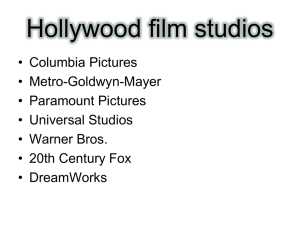


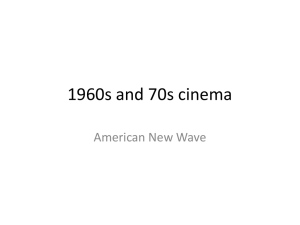
![[Lecture 19] studio system 2 for wiki](http://s2.studylib.net/store/data/005217793_1-c296c1b3b7b87d52a223478e417a702f-300x300.png)


